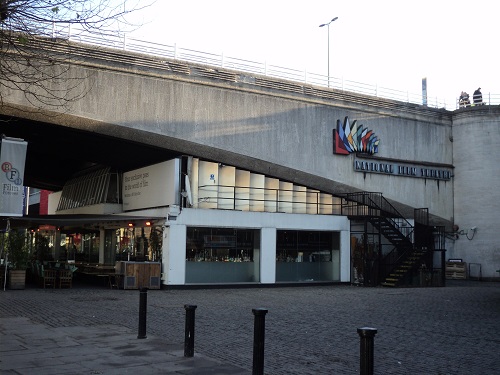
|
Buster Keaton Revivals in London,
1968 – 1987 Richard Warner Remembers |
|
Richard Warner, a jazz musician in England, has been watching Buster Keaton movies since 1971,
though “watching” is not exactly the correct word.
He has been studying and analyzing them.
He kept written and mental notes on all that he saw,
and his memories are the information I have been craving for decades.
His comments about the differences from one screening to the next,
from one video release to the next, have been immensely helpful, and he caught many details that eluded me.
|
|
As we learned from Ben Davis’s book,
Repertory Movie Theaters of New York City:
Havens for Revivals, Indies and the
|
|
With those preliminary words out of the way, let us now read Richard’s priceless memories.
|
| from: | Richard Warner |
| to: | RJ Buffalo |
| date: | Sep 2, 2024, 3:36 AM |
| subject: | KEATON & ROHAUER IN LONDON 1968–87 Part 1 |
|
KEATON & ROHAUER IN LONDON 1968–87 Part 1
|
|
I promised you details of the Keaton films I saw in the 1970s.
It’s sort of growing into the title you see on this email, which I will send in several parts as I write them!
|
 |
|
Rohauer provided the following films for the National Film Theatre’s 1968 Keaton Season:
|
|
• The Saphead.
|
|
• The ten independent silent features.
|
|
• All the Keaton silent shorts except The Love Nest and Hard Luck.
|
|
• The following Arbuckles —
The Butcher Boy,
Coney Island,
Out West,
Good Night Nurse,
Back Stage,
The Garage,
The Rough House and
The Hayseed.
The Bell Boy was advertised, but the unannounced Hayseed seems to have replaced it.
Judging by David Robinson’s 1969 book
(which was based on this season and private viewings of the films at the NFT),
Rohauer’s print of The Rough House was
|
|
The NFT season was a huge success, so the NFT mounted a
|
|
In 1971, the Keaton films were back at the Academy for a Summer Season.
I saw a poster for this on several London Underground stations (more on that in a later part).
I’d only seen bits of Keaton on TV in a series called “The Golden Silents”, so, intrigued, I went along.
I saw Steamboat Bill Junior with The Scarecrow and was totally knocked out.
I went to the other nine shows as soon as I could.
|
|
The season comprised the ten independent features, plus eleven shorts (two for Sherlock Jr.):
|
|
All prints began with “Raymond Rohauer presents THE FILMS OF BUSTER KEATON”,
followed by a second title mentioning that the films were shown by arrangement with RR and Leopold Friedman, Trustee.
All were prints of excellent quality, except where noted.
I use the word “title” to mean all cards, descriptive, dialogue etc.
Live piano accompaniment.
|
|
ONE WEEK — Fancy remade opening titles
(by “fancy” I mean ones with the ornate border with BK at the bottom, like the Sherlock Jr.
one you found on eBay).
Original titles thereafter.
|
|
COPS — Fancy remade titles throughout.
Stock police parade footage missing.
|
|
THE BALLOONATIC — Fancy remade titles throughout.
|
|
THE HIGH SIGN — Original titles throughout.
Clearly from a rather worn release print, but still sharp.
|
|
THE PLAY HOUSE — Plain remade titles throughout,
with an annoying “Buster Keaton Film Corp.” under the words for each title.
|
|
THE BOAT — As for The Play House.
The usual nitrate decomp visible.
|
|
MY WIFE’S RELATIONS — Fancy remade titles throughout.
One shot, where an “asleep” Buster is thumping his bride in the next bed, was out of focus.
|
|
THE HAUNTED HOUSE — Original titles throughout.
|
|
THE GOAT — Ditto.
|
|
THE SCARECROW — Ditto.
|
|
NEIGHBORS — Ditto.
|
|
COLLEGE — Ditto
|
|
OUR HOSPITALITY — Ditto
|
|
SEVEN CHANCES — Ditto.
Technicolor sequence merely
|
|
SHERLOCK JR. —
The “1968” version, with plain titles of a different font throughout.
A bit
|
|
BATTLING BUTLER — Original titles throughout.
|
|
THE NAVIGATOR — Original titles throughout.
Looked like a very good dupe of a release print, a bit worn.
|
|
THREE AGES — Plain, remade opening titles,
shakily photographed,
|
|
STEAMBOAT BILL, JR. —
Original titles throughout.
Same version as on Kino’s “Ultimate” set —
the print accompanied on that issue by a choice of the Biograph Players or Lee Erwin.
|
|
GO WEST — Fancy remade titles throughout.
|
|
THE GENERAL —
This began with a plain, modern title card which had a sort of catalog number,
which was a letter followed by three or four numbers, e.g. A1234.
Followed by THE GENERAL underneath.
It then went straight to the original “Western and Atlantic Flyer” card, skipping all the other opening credits.
At the time, I assumed (in my ignorance) that the wonderful Mr.
Rohauer had been given this print by some nice archive somewhere, but the lack of other credits annoyed me.
There’s nothing like this on your website.
Wish I could be more helpful!
|
|
Part Two and subsequent parts to follow when I’ve written them in a few days, or a week, or more!
|
| from: | Richard Warner |
| to: | RJ Buffalo |
| date: | Sep 3, 2024, 10:48 AM |
| subject: | KEATON & ROHAUER IN LONDON 1968–87 Part 2 |
|
KEATON & ROHAUER IN LONDON 1968–87 Part 2
|
|
Part 2 of my London saga.
This was supposed to cover the story up to and including 1973, but I turned up more stuff, so we’re still in 1971 here.
Parts 3 and 4 will cover 1972 and 1973 respectively.
|
|
After the 1971 Academy Season, the next Keaton I saw was The Paleface.
This toured the circuits as support to the 1971 film Tales of Beatrix Potter.
At the time, I lived near Catford, a none-too-salubrious part of South London.
The local paper listed these two films as showing at the local ABC Cinema, so I went along on Saturday, September 4th, 1971.
It was a disaster.
Kids running up and down the aisles and chattering
|
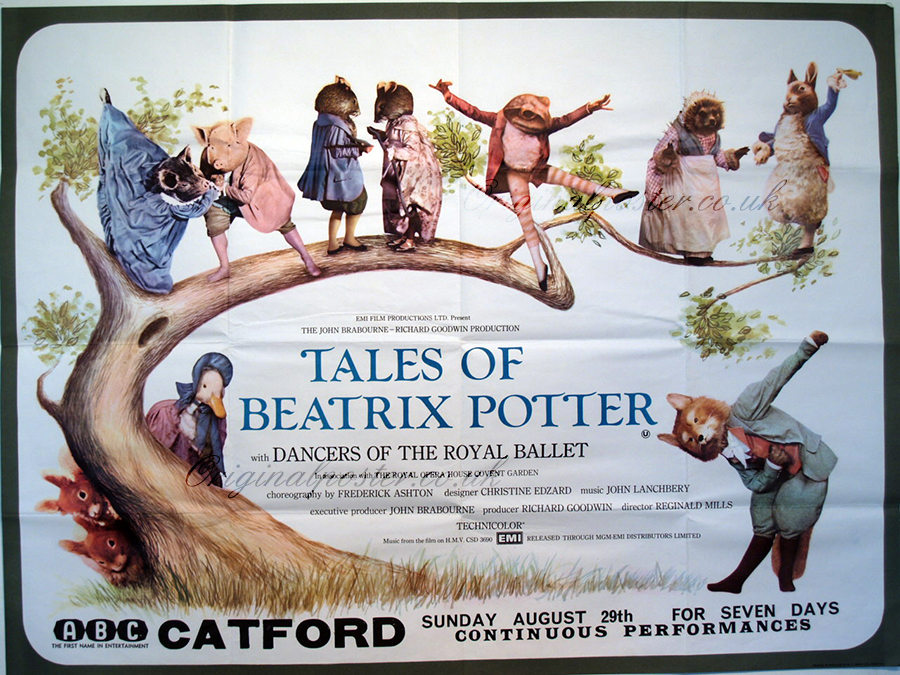 |
|
Incredibly, I found a picture of the Beatrix Potter poster on the internet —
for the very cinema in question, although the Keaton short isn’t mentioned.
It’s attached, together with another remarkable find —
a rather fuzzy shot (also from the internet) of a page from the London listings magazine Time Out
for 13th to 19th August 1971.
Under Cinema it says, “In the West End,
don’t miss the last week of Buster Keaton (Academy)”
and the final column mentions that Buster’s Paleface is on release with the Beatrix Potter film.
|
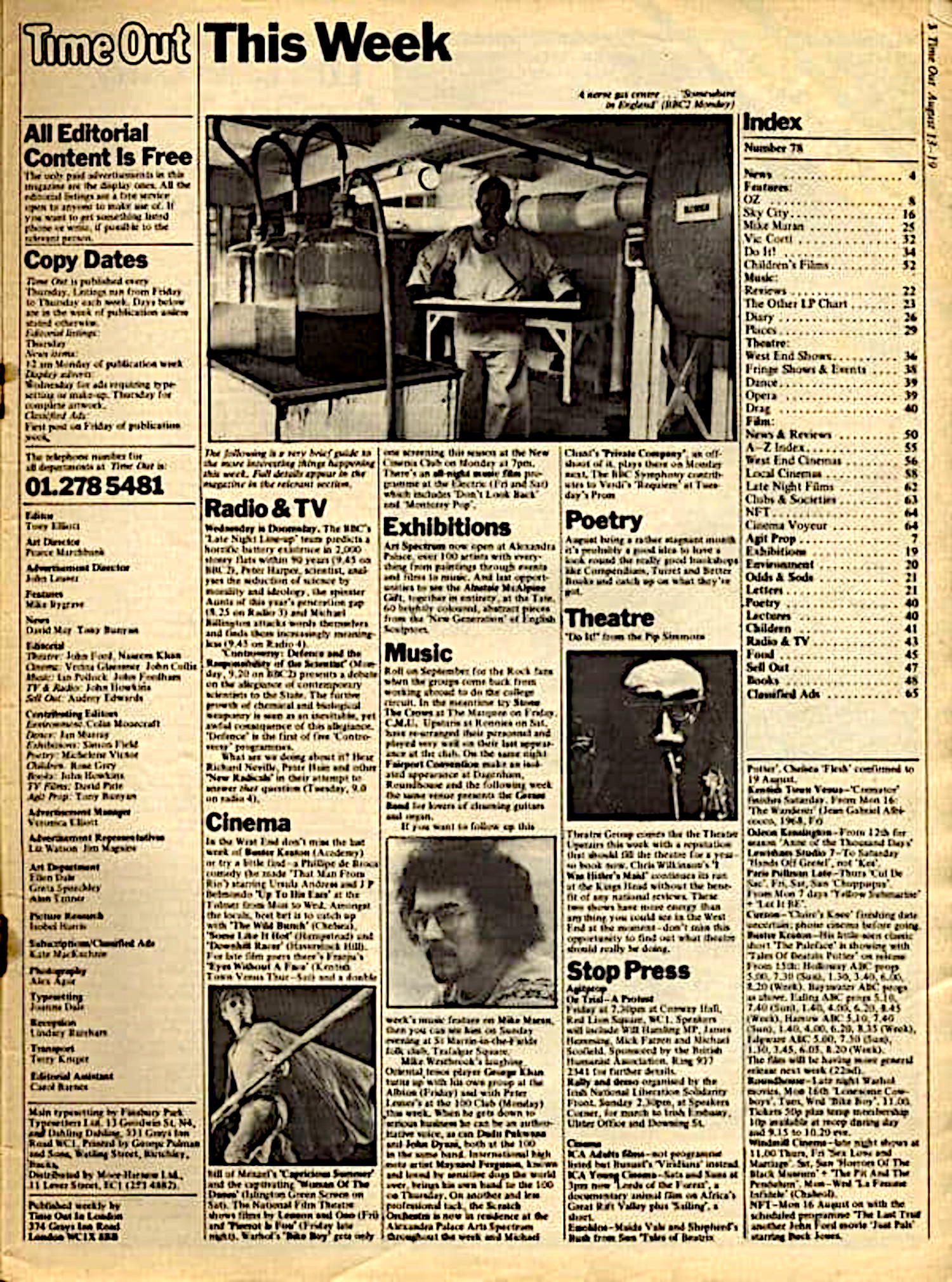 |
|
I’ve also attached three photos of the Academy Cinema.
|
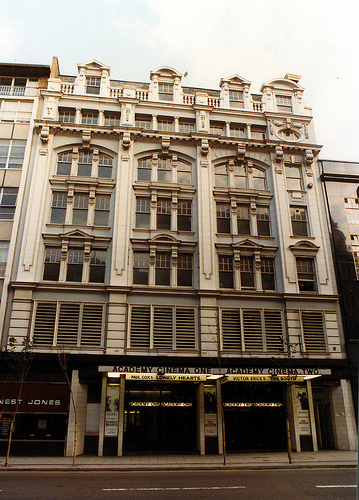 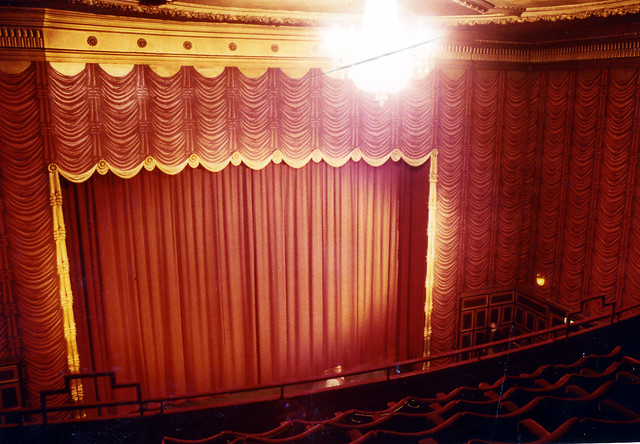 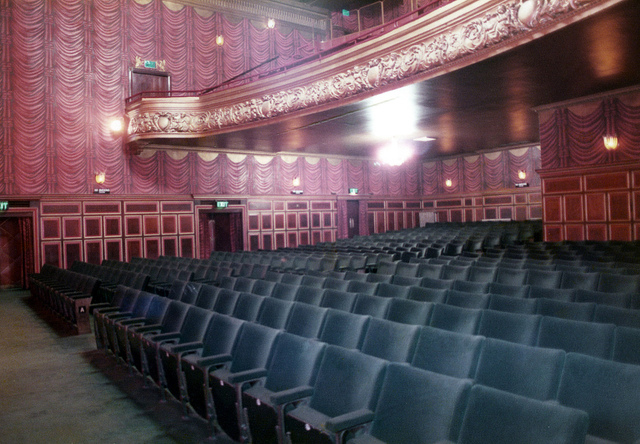
|
| from: | Richard Warner |
| to: | RJ Buffalo |
| date: | Sep 3, 2024, 2:44 PM |
| subject: | KEATON & ROHAUER IN LONDON 1968–87 Part 3 |
|
KEATON & ROHAUER IN LONDON 1968–87 Part 3
|
|
Here’s a brief Part 3.
|
|
After my 1971 Paleface disaster, things looked up in 1972 with another Keaton Season at the Academy.
Same films as the previous year, and same prints, but I went to see them all again.
The place was always packed.
|
|
There was also a Raymond Rohauer D.W. Griffith Season at the NFT.
I went to see Birth of a Nation and Intolerance.
The prints were terrible.
|
|
Then came the attached article in Time Out, the first intimation I had that RR might be less than saintly!
|
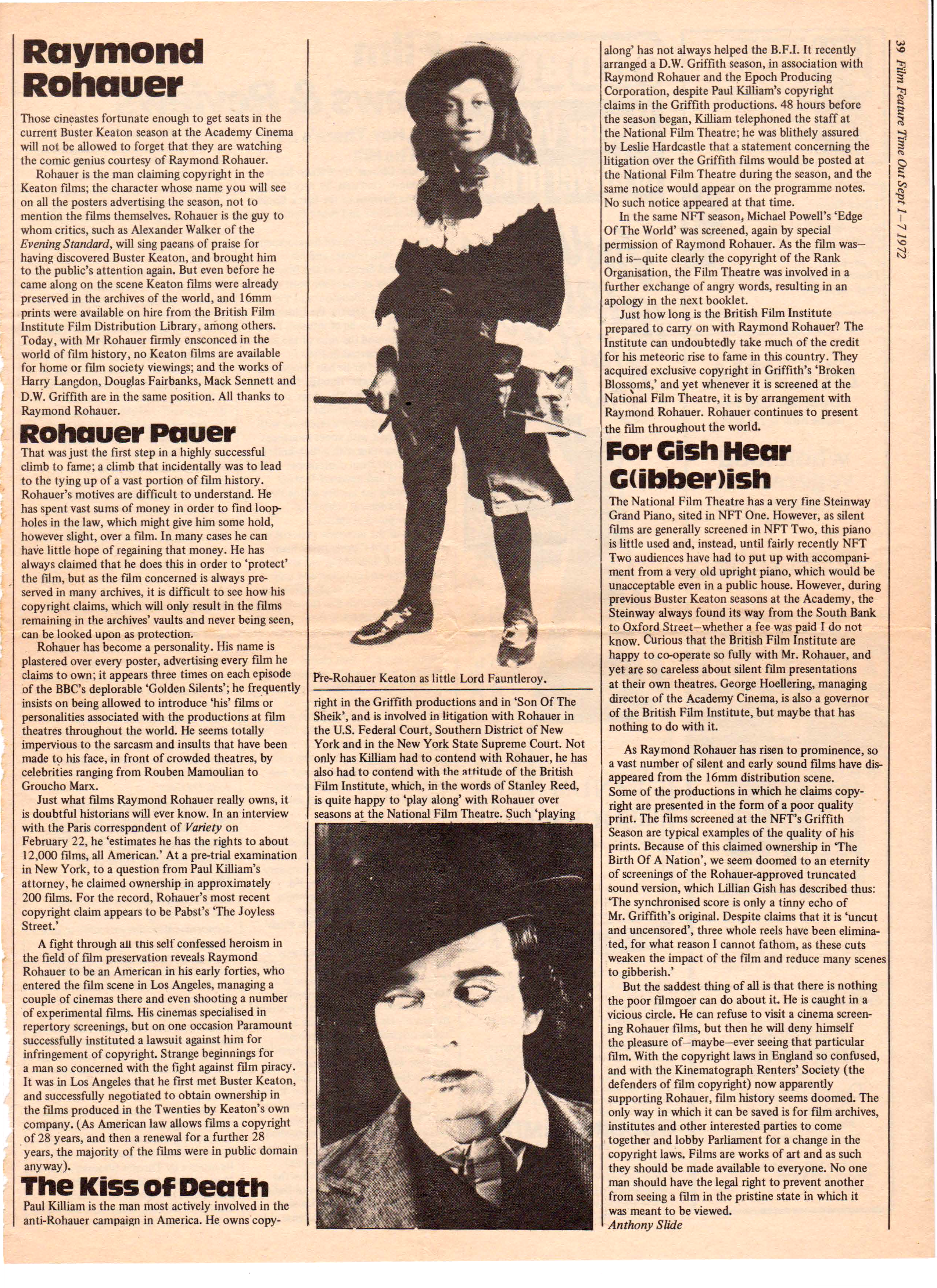 |
|
Part Four will contain more on Keaton prints.
To follow in due course.....
|
| from: | Richard Warner |
| to: | RJ Buffalo |
| date: | Sep 4, 2024, 4:11 AM |
| subject: | KEATON & ROHAUER IN LONDON 1968–87 Part 4 |
|
KEATON & ROHAUER IN LONDON 1968–87 Part 4
|
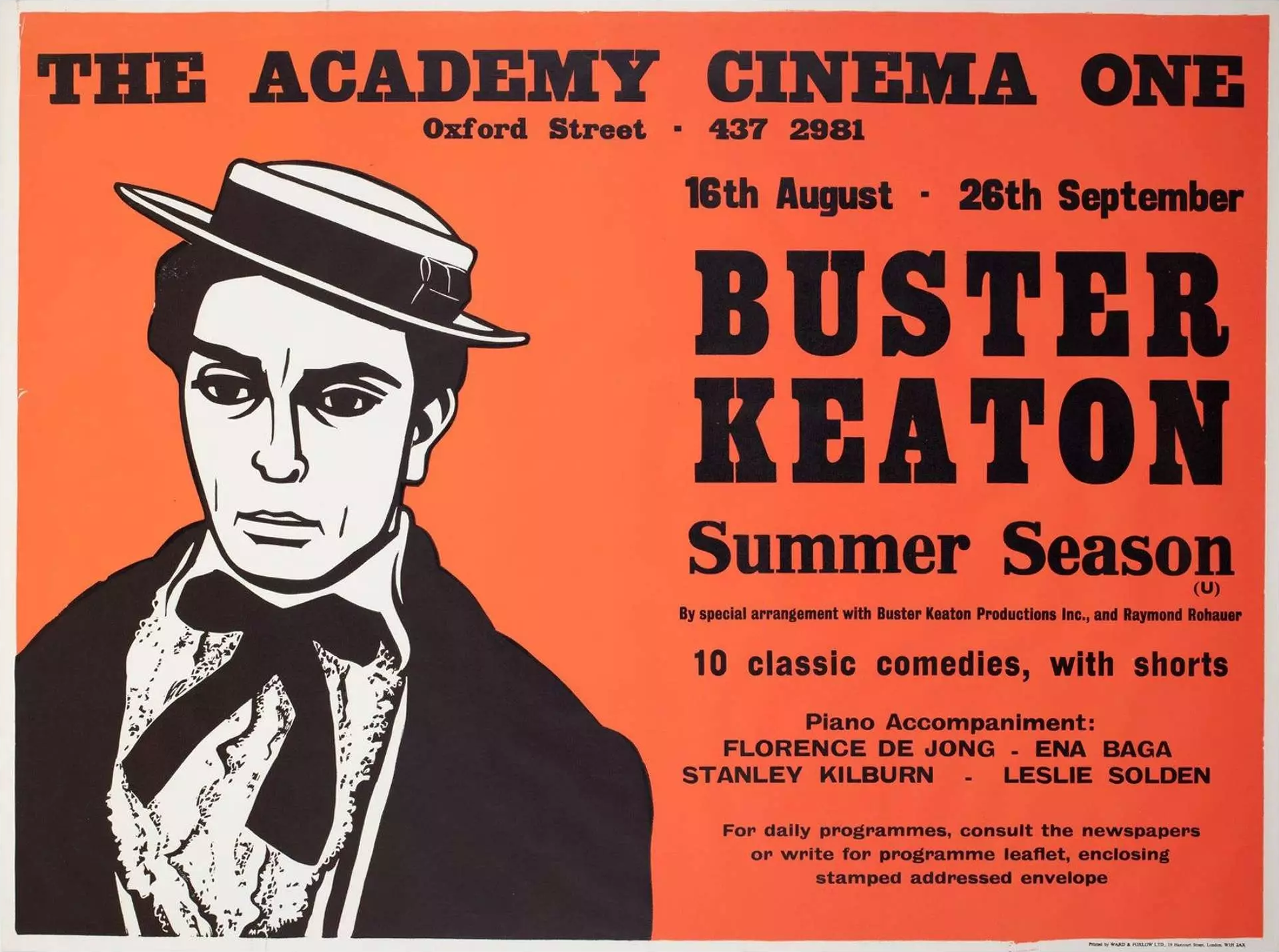
|
|
For the rest of the Seventies, the now-familiar orange posters would appear on the London Underground stations most years,
advertising yet another Buster Keaton Summer Season at the Academy,
so it was off to Oxford Street to pick up another of their dates-of-showing/booking-form leaflets.
(In later years, those 9-inch by 6-inch leaflets always came to mind
when I fondly recalled the Academy Seasons, and I cursed the fact that
that I hadn’t saved one — or so I thought.
During a recent tidy-up, this one for the 1979 Summer Season fell out of an old magazine,
and, happily, the picture of a surviving poster is from the same year!)
|
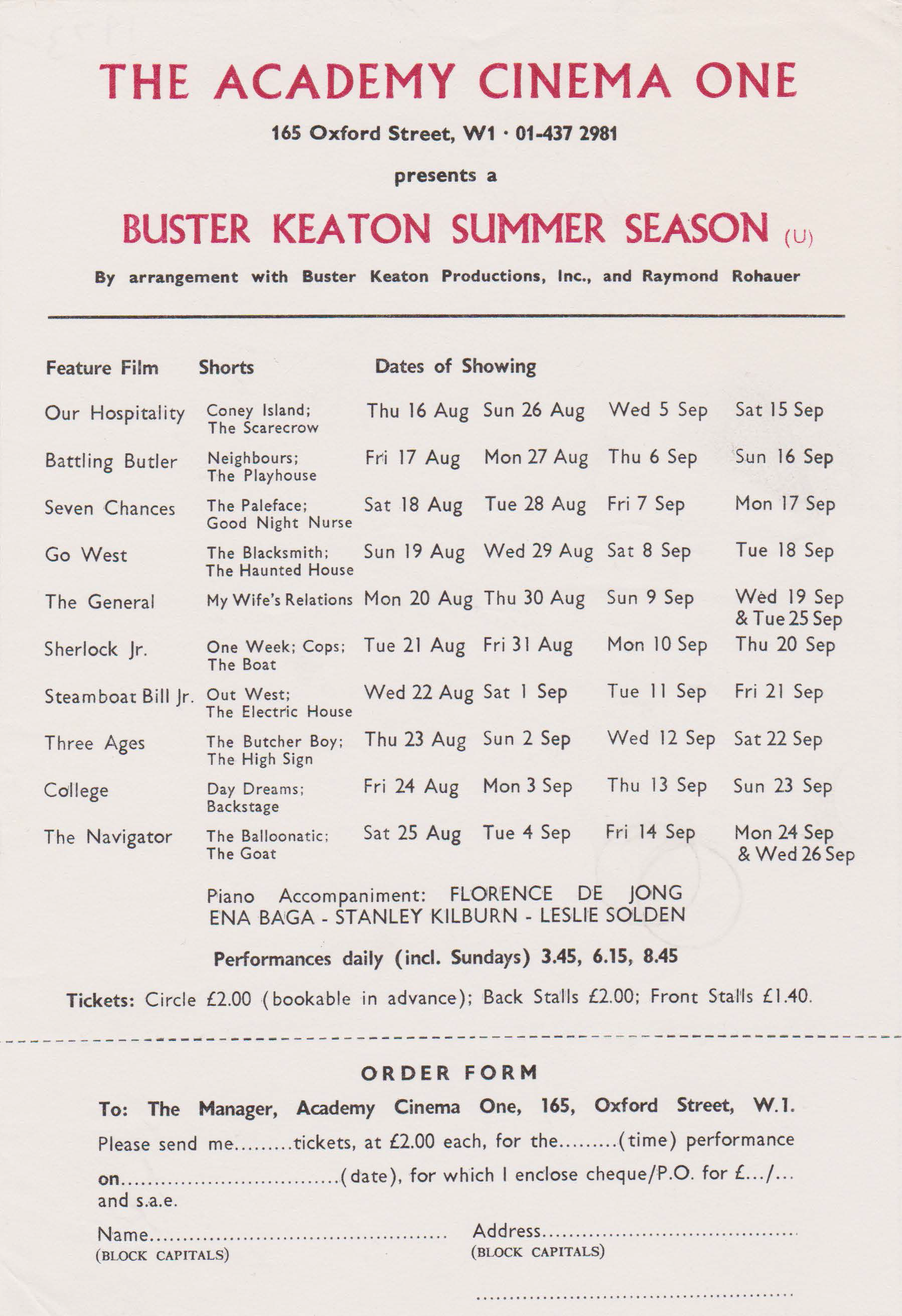
|
|
By the
|
|
THE PALEFACE — Same fancy titles version used for the Beatrix Potter release, sans soundtrack.
Excellent quality in parts, with other parts from a lesser print
(as with the “Art of Buster Keaton” and Kino “Ultimate” versions).
|
|
CONEY ISLAND — Vintage titles throughout (from a reissue version, I believe).
|
|
THE BUTCHER BOY — Plain remade titles.
|
|
GOOD NIGHT NURSE — Plain remade titles.
|
|
BACK STAGE — Plain remade titles.
|
|
OUT WEST — Plain remade titles.
Definitely titled OUT WEST not A DESERT HERO.
Sharp but very scratchy print.
Same version as this (with new titles) on the two-disc Kino Arbuckle & Keaton set.
Same applies to the other four Arbuckles included here.
|
|
DAY DREAMS — Plain remade titles.
Sharp but very scratchy print.
It seems that two surviving prints of this film existed.
This foreign one (originally with Czech titles), and an incomplete domestic print found (I think) by Bill Everson,
which was included in “The Great Stone Face” and Robert Youngson’s “Thirty Years of Fun”.
“The Art of Buster Keaton” and Kino “Ultimate” use both sources.
Lobster’s 2001 version uses the same Czech source that Rohauer had,
plus a Dutch fragment of Buster as Police Chief, with a printed-in hair in the gate!
Lobster’s later
|
|
THE BLACKSMITH — Fancy Rohauer titles throughout.
By this time, I had acquired my first 8mm Keatons from Perry’s Movies of Wimbledon, South London.
These were Cops, Blacksmith, Coney Island, One Week.
“My” Blacksmith had original titles, including the one where Buster pulls down the shade with THE END on it.
In Rohauer’s print, Buster pulled down the shade until just before THE END appeared, then it cut to Rohauer’s fancy end title.
No expensive lab wipes, dissolves and suchlike for our RR!
|
|
THE ELECTRIC HOUSE — Disaster! Rohauer’s print had none of his own titles,
apart from the two “RR presents .....
Leopold Friedman” ones at the start.
Everything else was in Czech!
Grumbles and complaints from the audience.
|
|
There was a second Rohauer presentation at the Academy in the early 70s.
This was a season of Douglas Fairbanks silent features, again with live piano accompaniment.
I went to see The Black Pirate and Robin Hood.
The Black Pirate’s early color was a little faded, but it was a very nice print.
Robin Hood was a lousy print — blurry, washed out.
It looked like a bad blow-up from a very bad 16mm! It was so very, very, bad that I and others walked out.
|
|
There were sometimes Buster Keaton Christmas Seasons at the Academy
instead of, or in addition to, the Summer Seasons.
The programme was always the same 10 features and 20 shorts and the prints
(by now accumulating brand new damage of their own!) remained the same.
There were only two changes.
Rohauer tacked on a title at the beginning of Three Ages,
NOT the one to be seen in the “Buster Keaton Chronicles” DVD set.
This one said “We are unable to show a better print of this film,
owing to the condition of the original negative”.
The Electric House disaster was remedied with newly made English titles,
unlike any other in any Rohauer print I’ve seen.
A white border consisting of a single straight-line rectangle, with rounded corners.
I think they were made locally and spliced into the previous Czech print!
|
|
Incidentally, I always thought that David Shepard fixed the unwatchable Roman Chariot sequence
and final
|
|
While these Keaton Seasons were running at the Academy,
Rohauer and Buster popped up elsewhere in London, separately and together, during the Seventies.
More about those appearances in the next installment.
|
|
All the best,
|
|
Richard
|
| from: | Richard Warner |
| to: | RJ Buffalo |
| date: | Sep 12, 2024, 2:04 AM |
| subject: | KEATON & ROHAUER IN LONDON 1968–87 Part 5 |
|
KEATON & ROHAUER IN LONDON 1968–87 Part 5
|
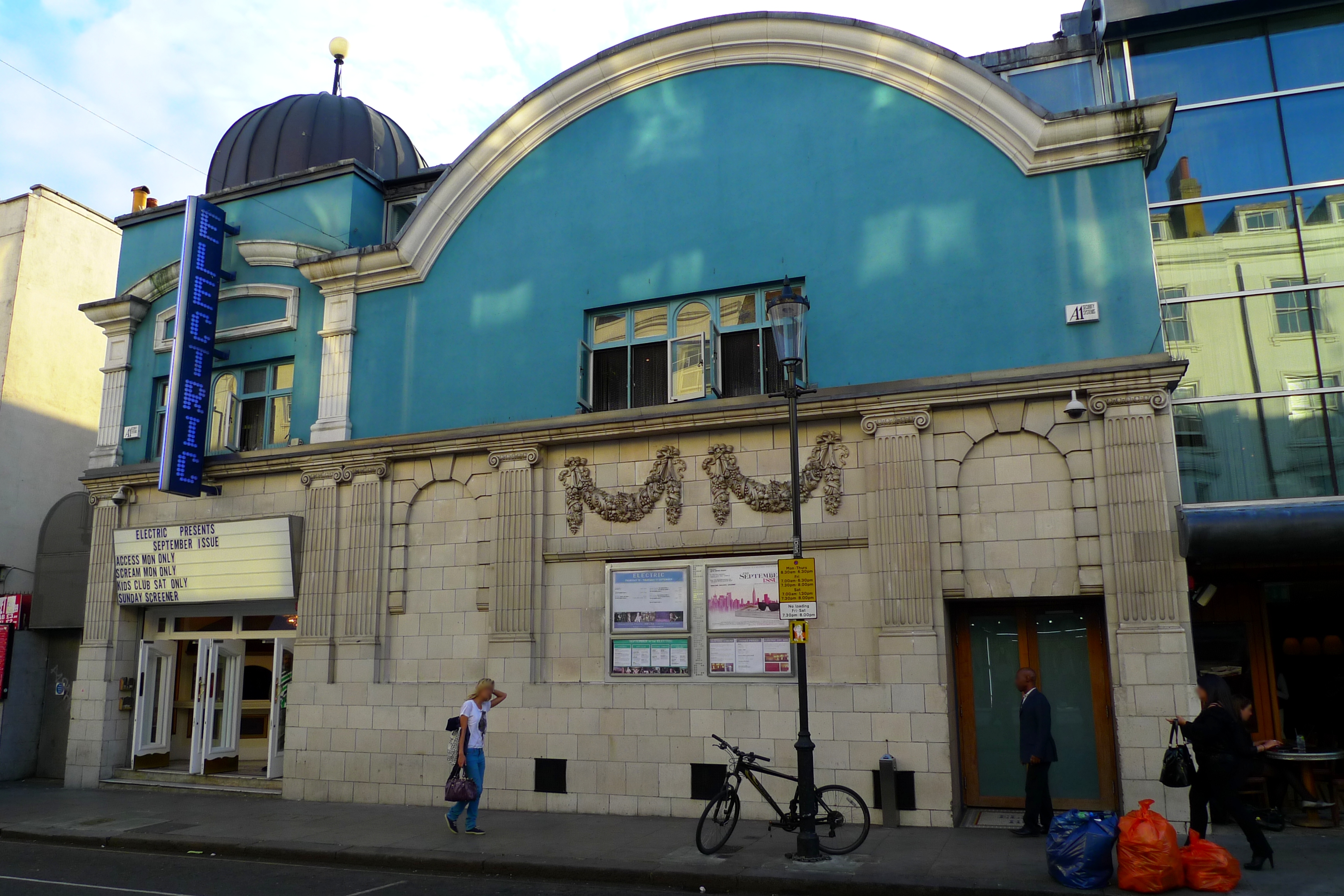
|
|
Sometime in 1974 or 1975, Buster and Rohauer popped up at the Gate Cinema, Notting Hill, West London.
This was one of two repertory cinemas in this area, the other being The Electric Cinema in Portobello Road.
At the Gate, we were treated to The Saphead,
on a bill with Arbuckle’s The Bell Boy and Rohauer’s
|
|
I think this was the first occasion in London at which Rohauer used prints
other than those he had brought over for the 1971 Keaton Season at the NFT.
The Bell Boy had been announced in 1968, but it failed to appear.
I suspect The Saphead in 1968 might have been the “alternate” one
seen on Kino’s “Ultimate” Set,
as I overheard a member of the audience telling his friend that the 1968 screening had been all black and white.
According to David Robinson’s 1969 book,
Rohauer seems to have supplied an
|
|
Around the same time, the Gate ran three Harry Langdon features from Rohauer,
Tramp, Tramp, Tramp, The Strong Man and Long Pants.
I saw Long Pants, which looked like 35mm blown up from good 16mm, again with a “78” score.
|
|
Harris Films, a UK 16mm distributor, obtained
The Cameraman,
Spite Marriage and
Sidewalks of New York from Films Incorporated in the USA, and I saw them all in
|
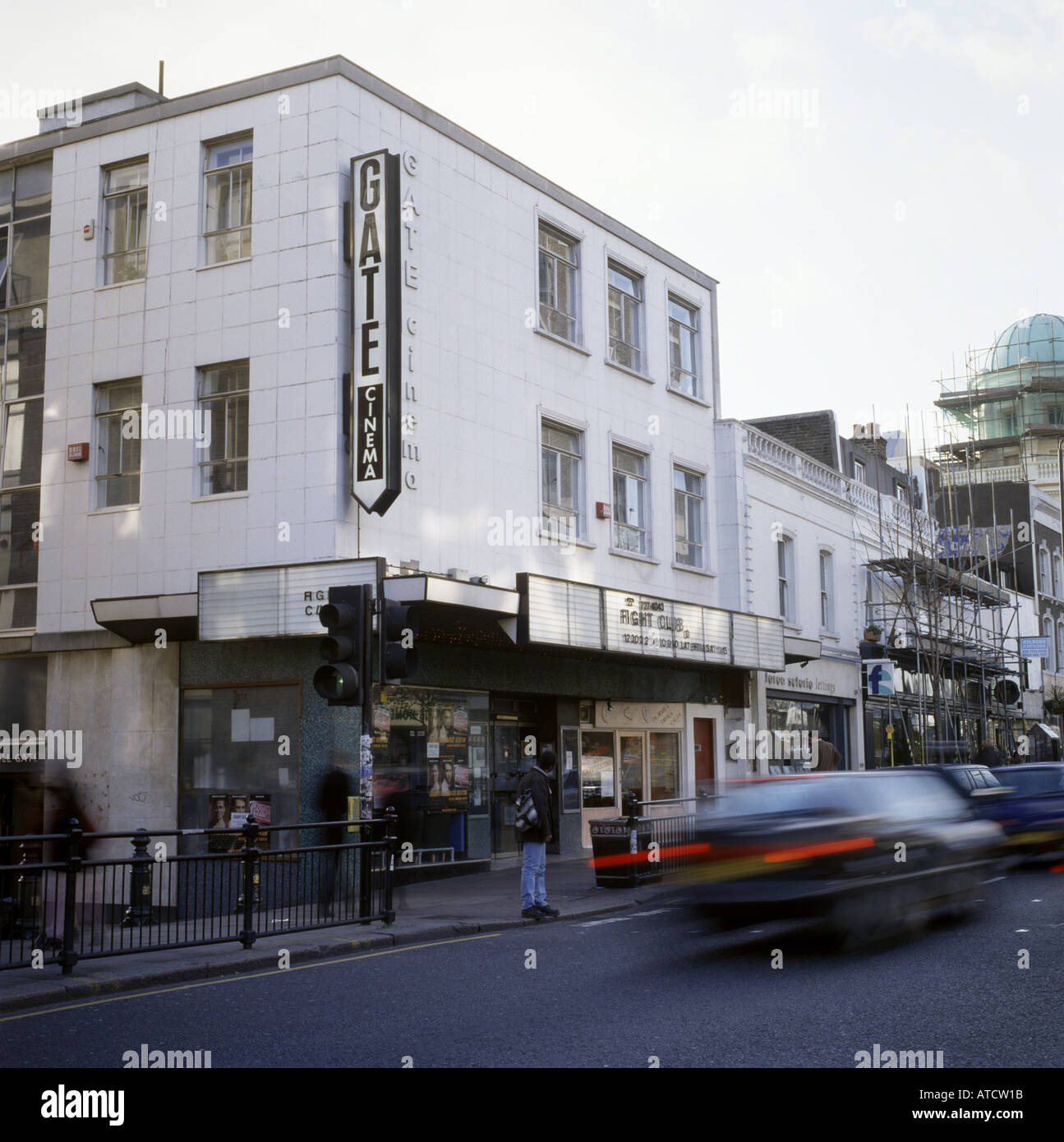
|
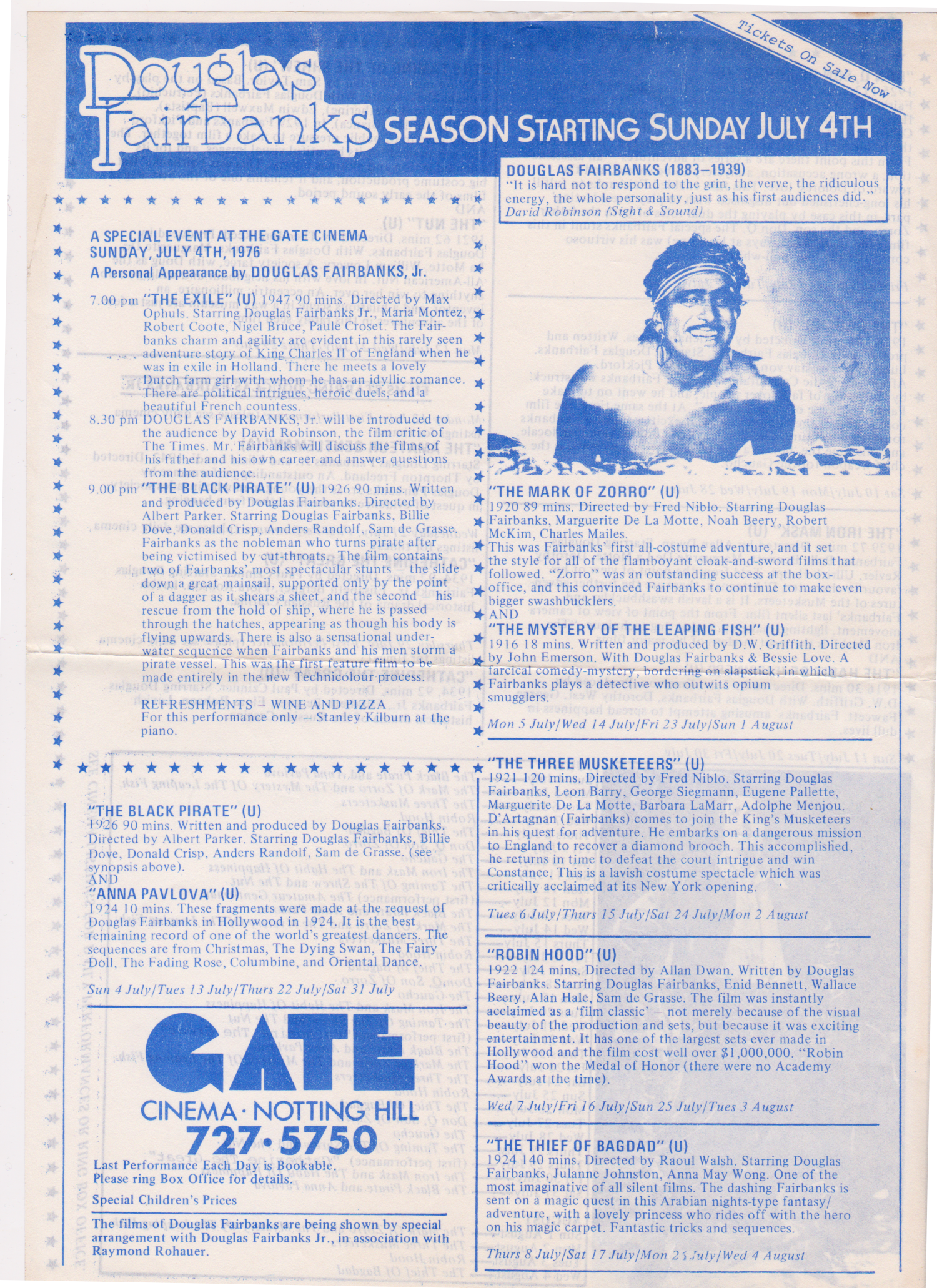
|
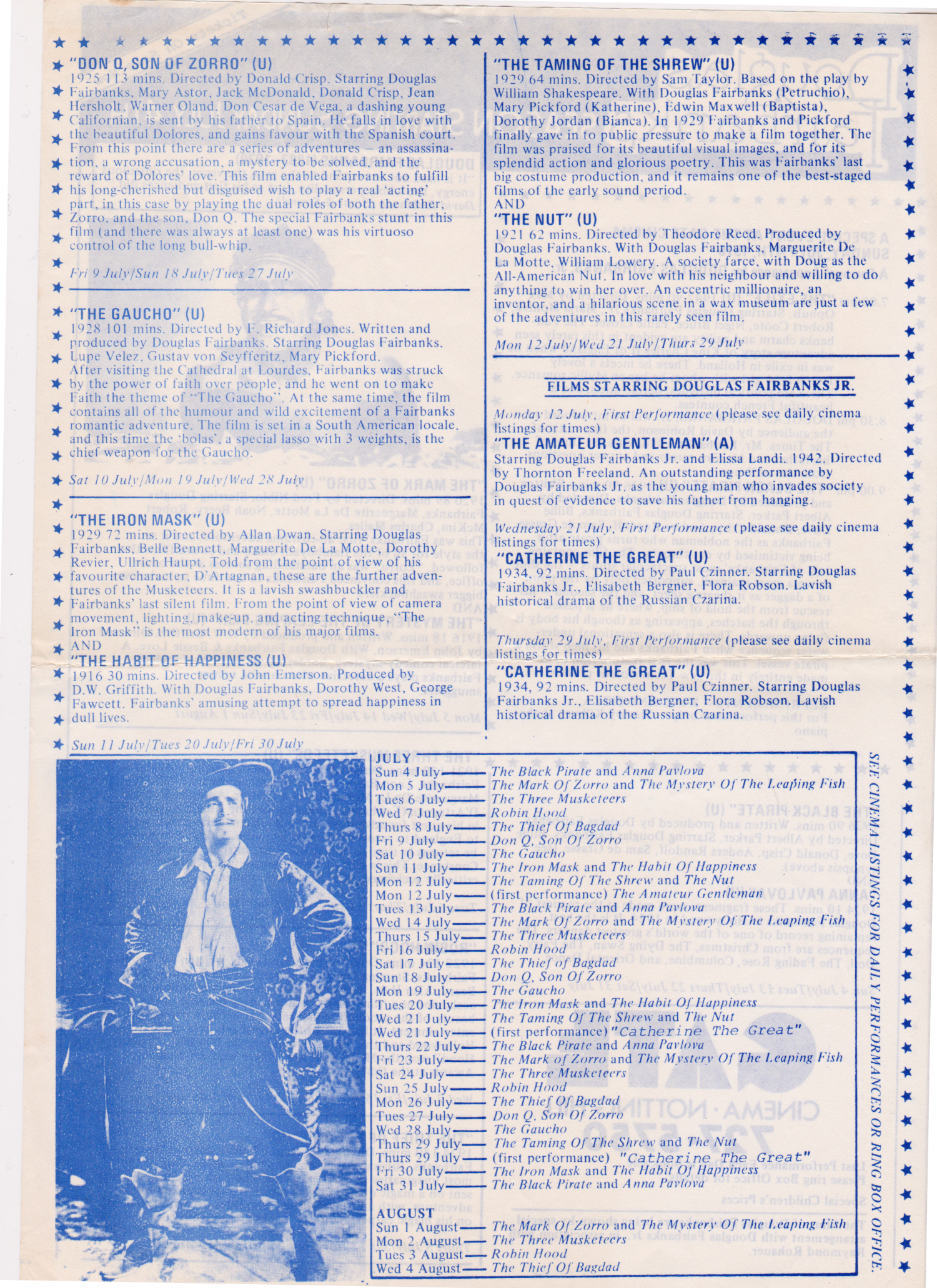
|
|
The Gate also played host to another Rohauer Fairbanks season in 1976.
I got a leaflet for it, but (perhaps put off by my Robin Hood experience) didn’t go to this season.
|
|
When in London, Rohauer stayed at the Mayfair Hotel, which had its own basement cinema, open to the general public.
Rohauer sometimes provided films from his collection for screening there.
One such was The Crazy World of Laurel & Hardy, which I saw there in a pristine print.
I also saw the
|
|
In the latter half of the 1970s, The Electric Cinema in Portobello Road screened several Rohauer films.
I saw Langdon’s Three’s a Crowd and The Chaser there,
a double bill which played to a nearly empty auditorium,
with the first film marred by bouts of nitrate decomposition, the second seemingly blown up from cropped 16mm in parts.
Both films were accompanied by
|
|
Other 1970s Keaton treats at the NFT included Hollywood Revue of 1929,
marred by faulty, distorted printing of the color sequences,
plus some of Buster’s Educational and Columbia shorts were shown as support in
Marx Bros., W.C. Fields and Mae West seasons.
The first one I saw was Ditto.
I had yet to encounter Sidewalks of New York,
so this was my first experience of the Keaton voice, much deeper than expected.
In May 1979, The General was shown as part of the
NFT’s Great Movie Stars season of 40 films, only five of them silent.
I didn’t go, as I had my own Blackhawk print by then.
Bill Everson presented some juicy rarities in a couple of NFT appearances,
including Langdon’s A Soldier’s Plaything,
the deleted Fields sequence from Tales of Manhattan and, best of all,
Keaton’s Le Roi des Champs-Élysæes, which actually got a round of applause at the end.
Sadly, a screening of The Invader at the Barbican Cinema received nothing but groans!
|
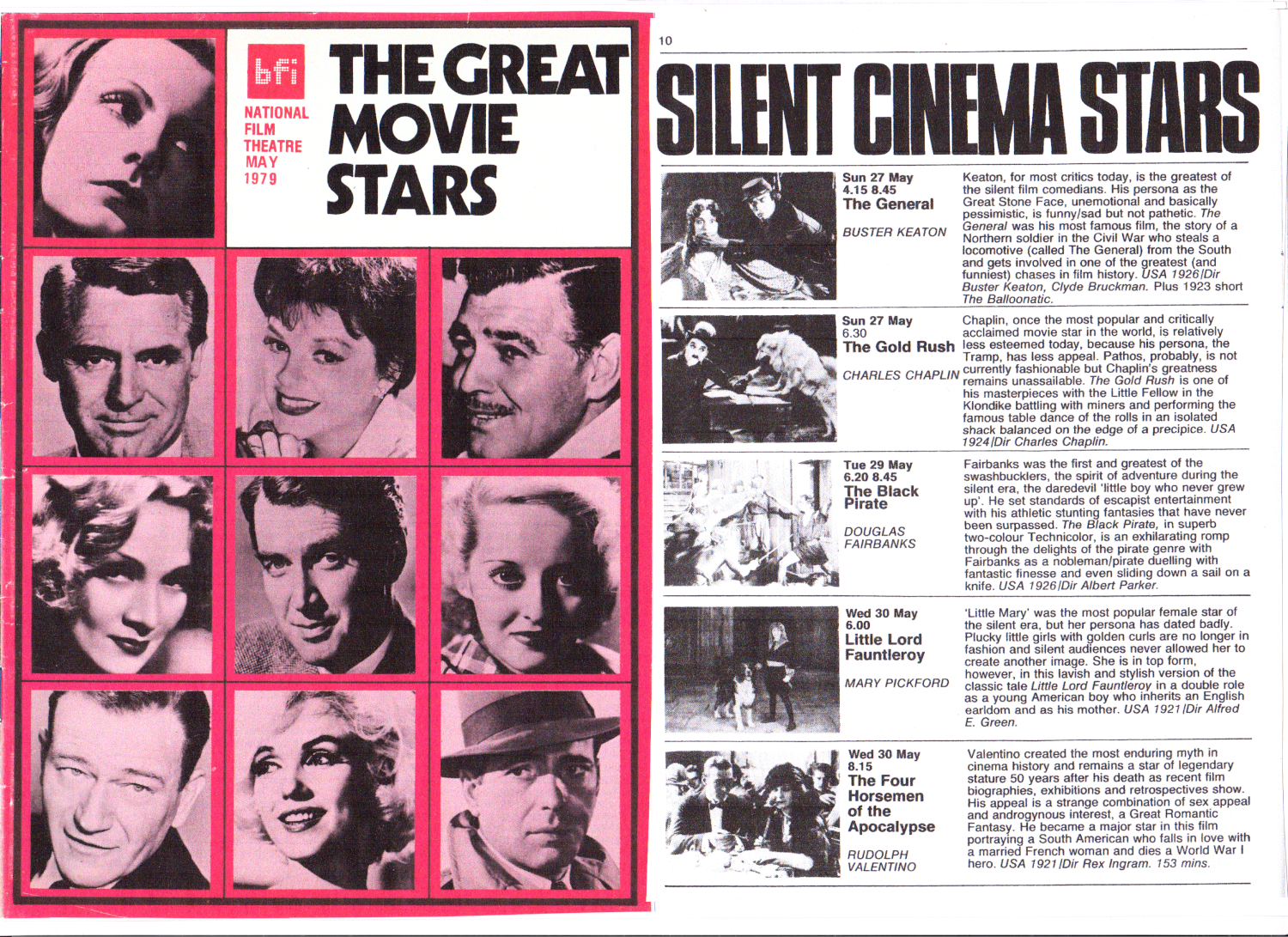
|
| from: | Richard Warner |
| to: | RJ Buffalo |
| date: | Sep 17, 2024, 2:28 AM |
| subject: | London Part 6 (conclusion) |
|
KEATON & ROHAUER IN LONDON 1968–87 Part 6
|
|
By the early 1980s, work, travel abroad on business, moonlighting as a jazz musician,
marriage and fatherhood had all curtailed my cinemagoing.
There was a 1987 Keaton Season at the NFT.
They screened Hollywood Revue of 1929 again in May 1980.
In the mid-1980s Rohauer’s Keaton Seasons could be found
at the Institute of Contemporary Arts’ cinema in The Mall, near Buckingham Palace.
I went to none of these, but there were still two major Keaton & Rohauer surprises for me.
|
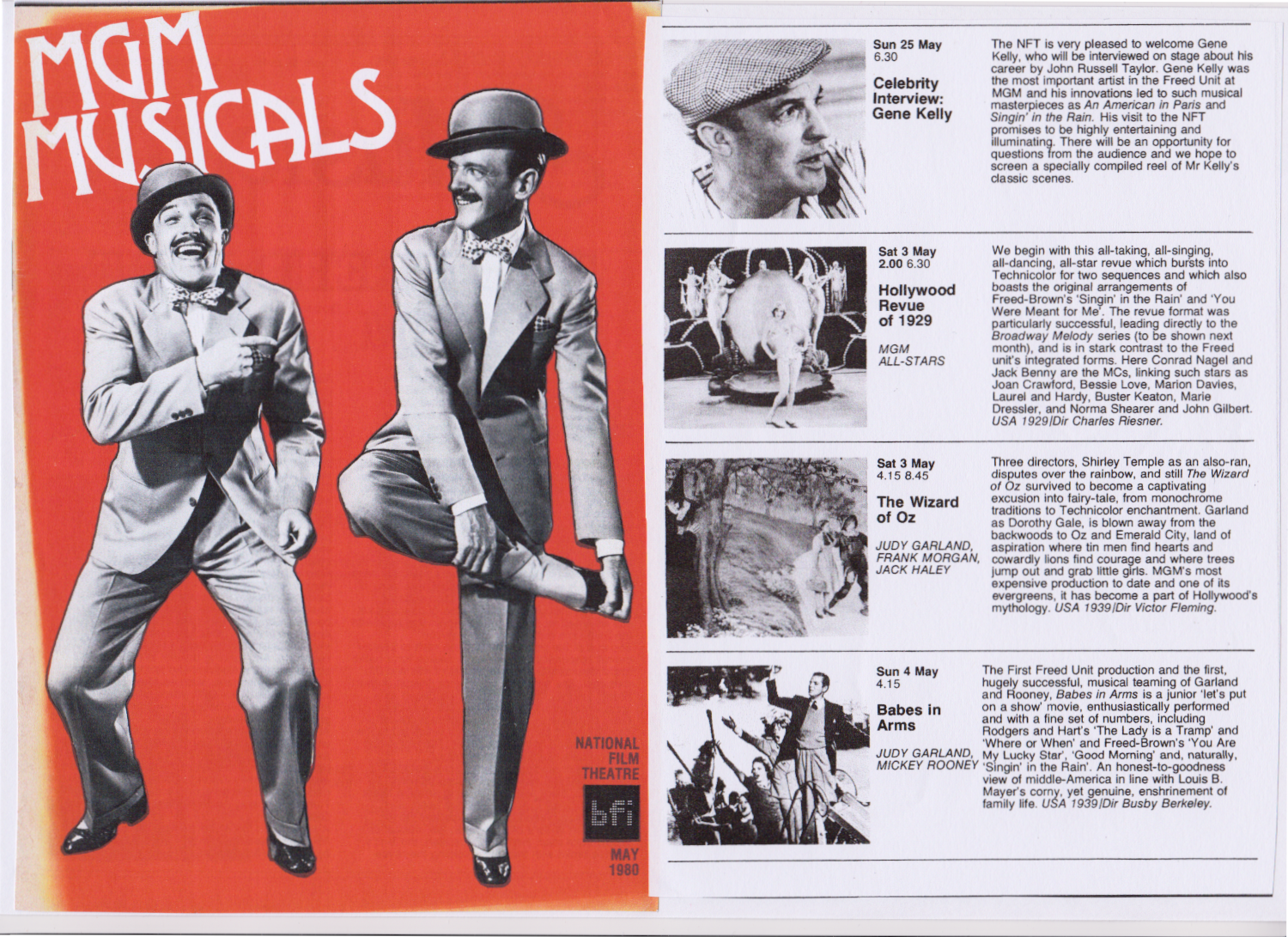
|
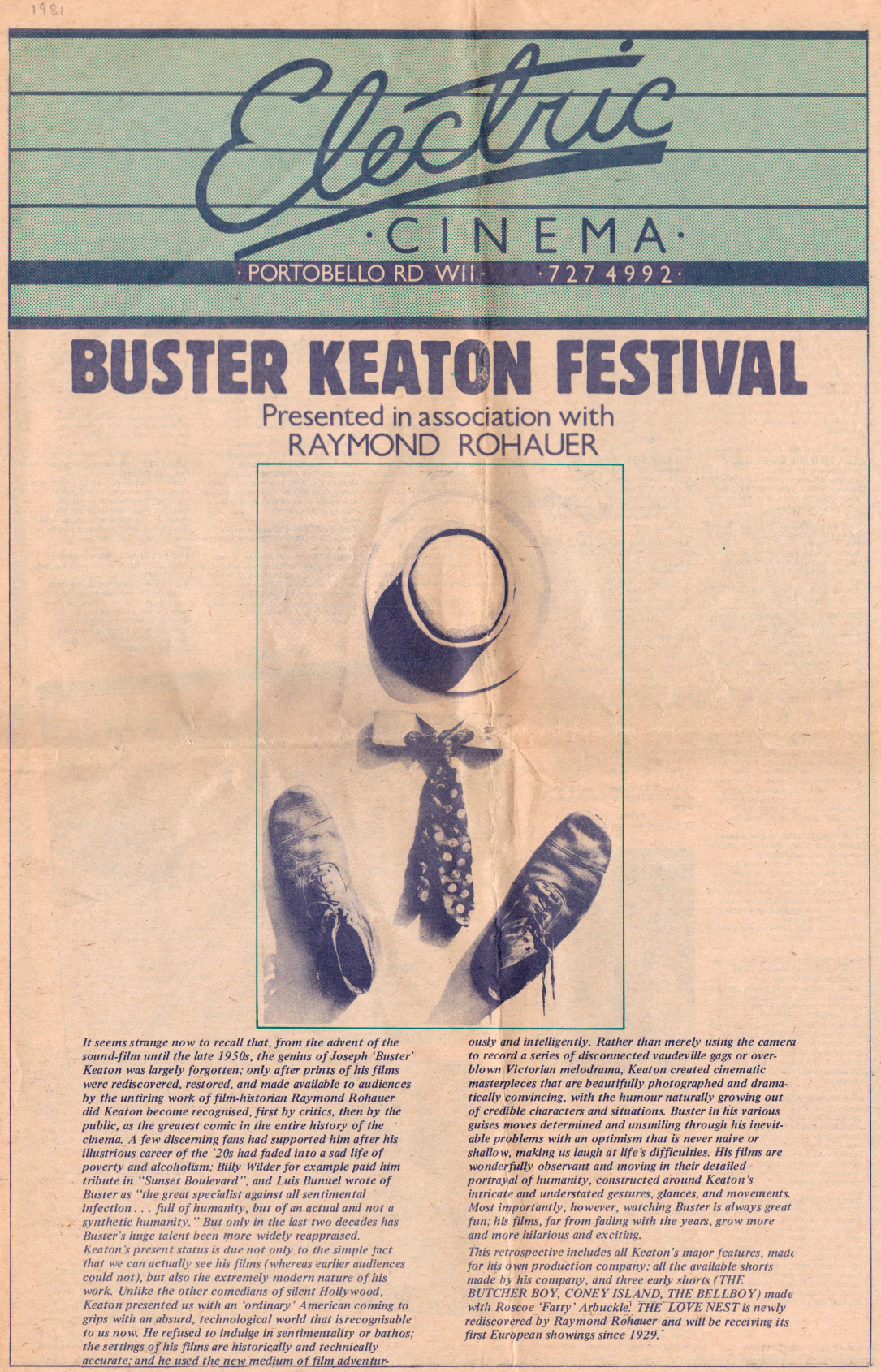 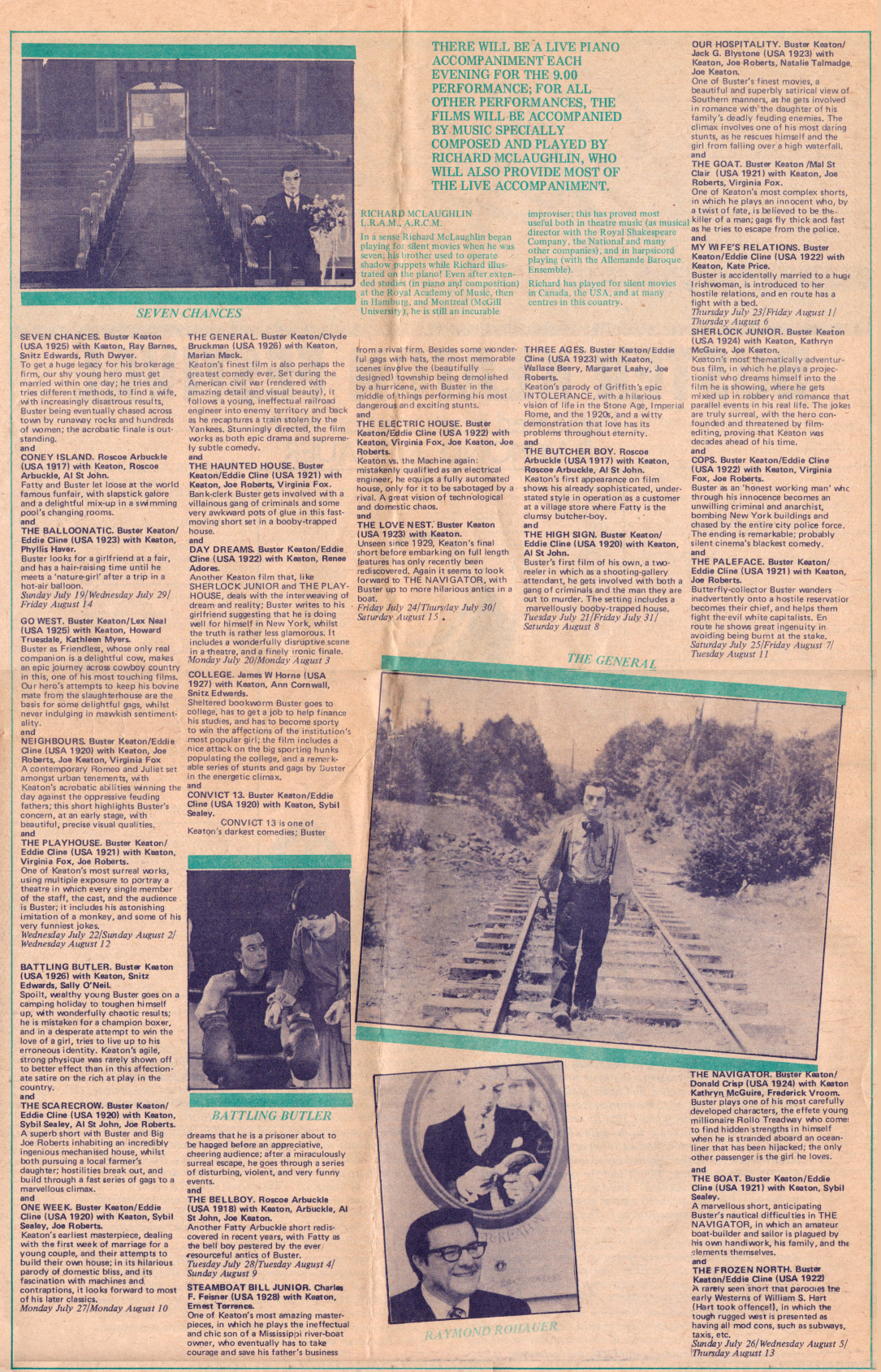
|
|
In 1981, I was travelling home from work, reading my London Evening Standard newspaper on the train.
Film critic Alexander Walker’s column mentioned a new Keaton Season
at the Electric Cinema in Portobello Road — the Academy seasons had ended, and the ICA ones had yet to start.
Walker mentioned the season would include the
|
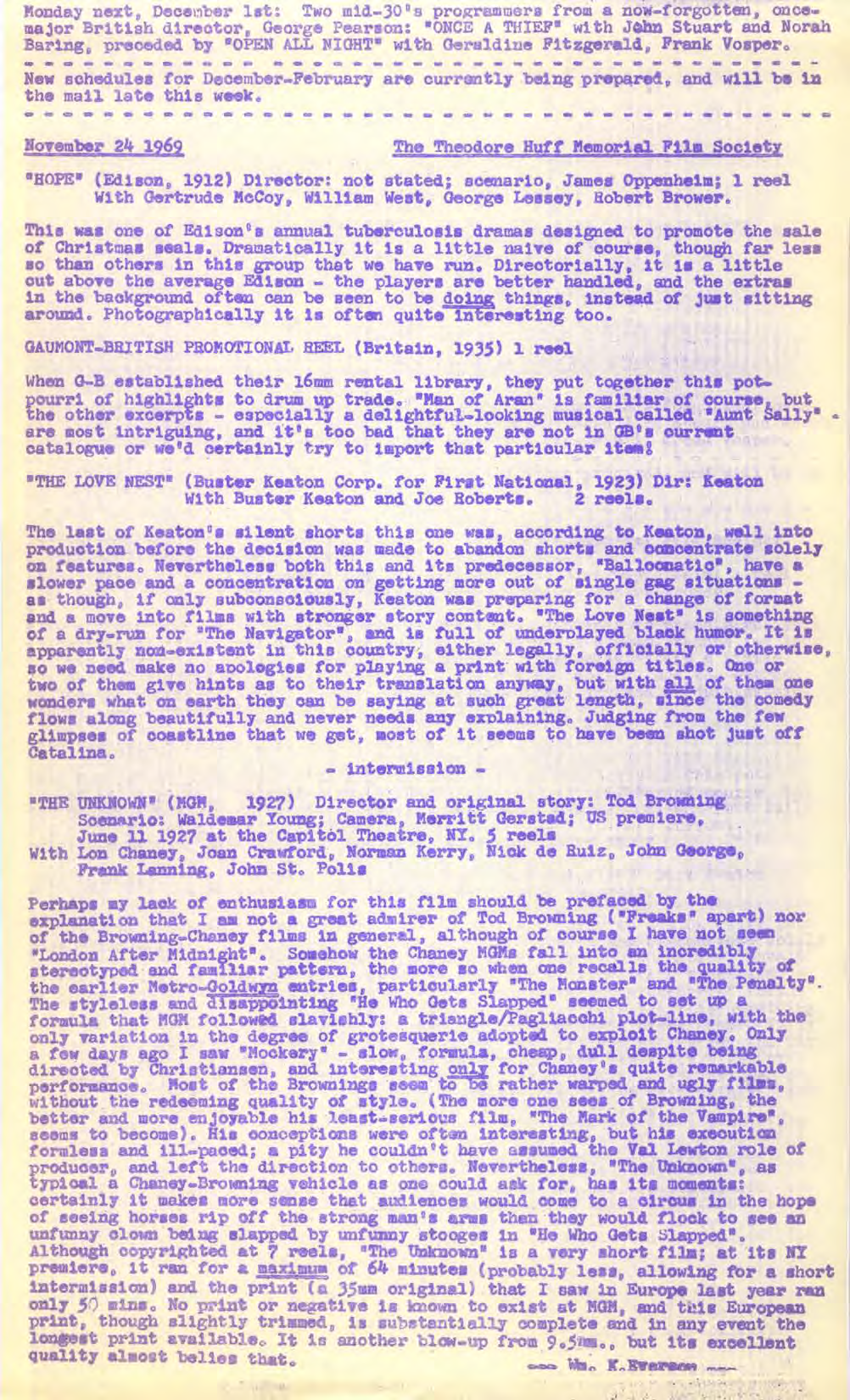 |
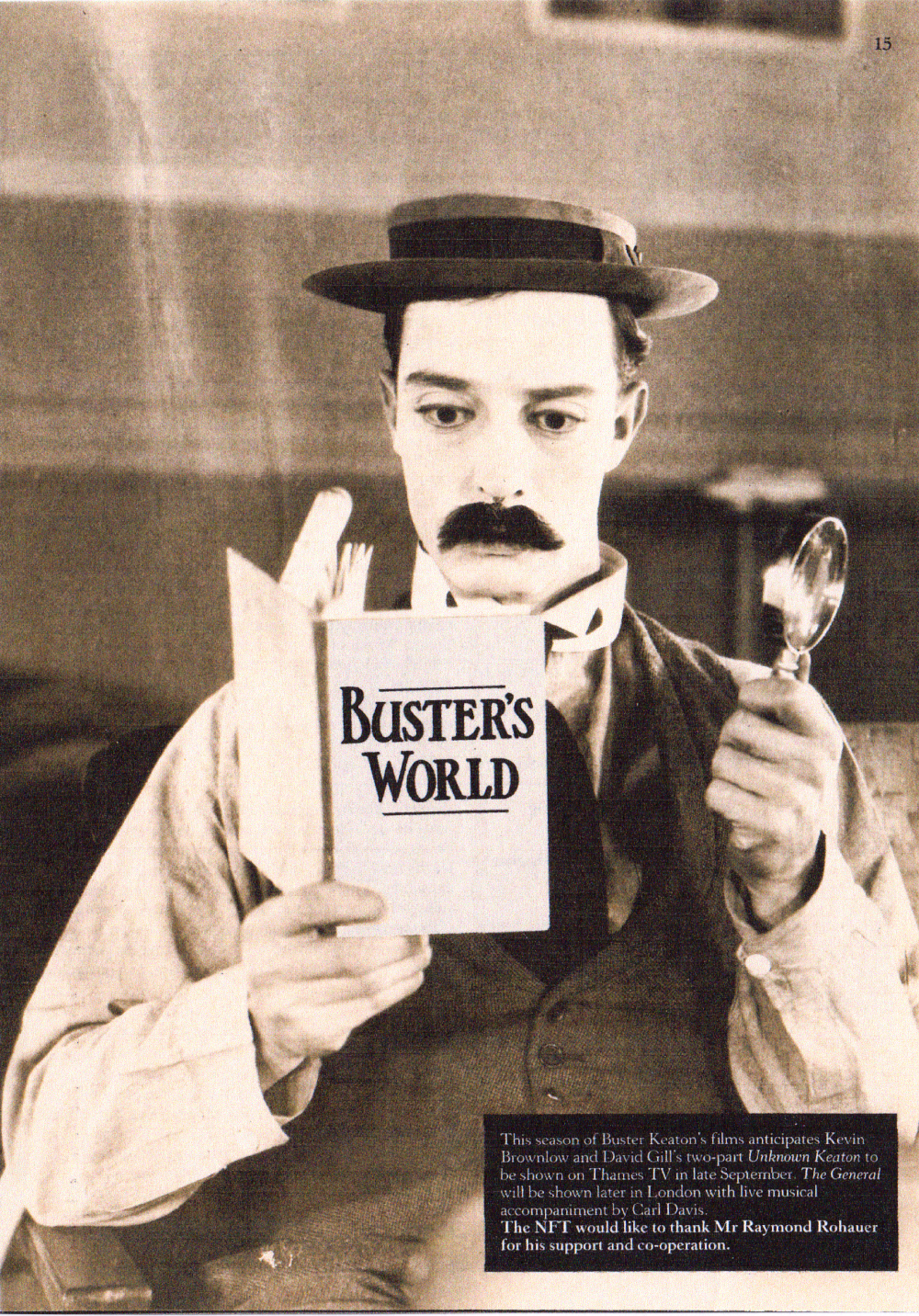 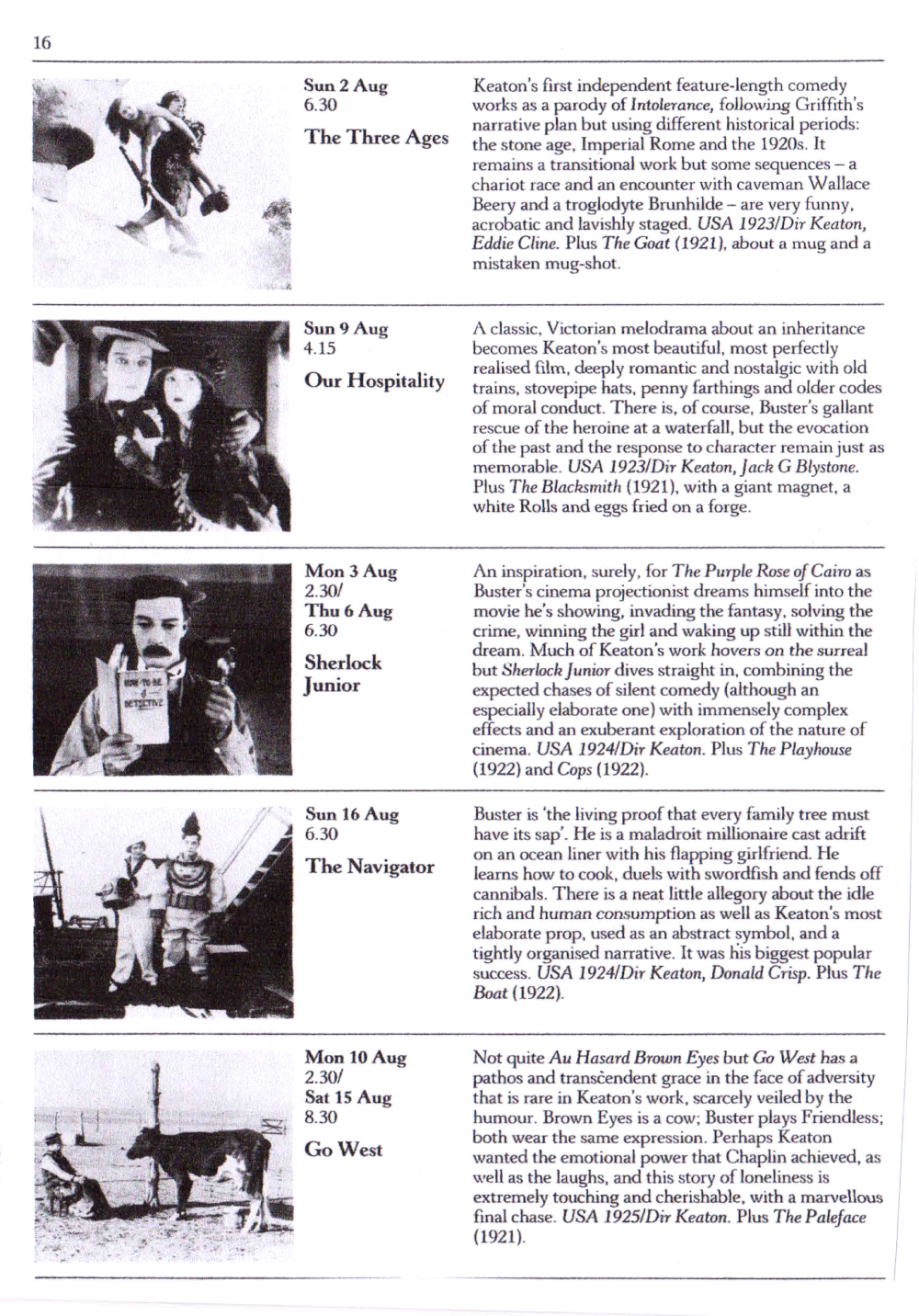 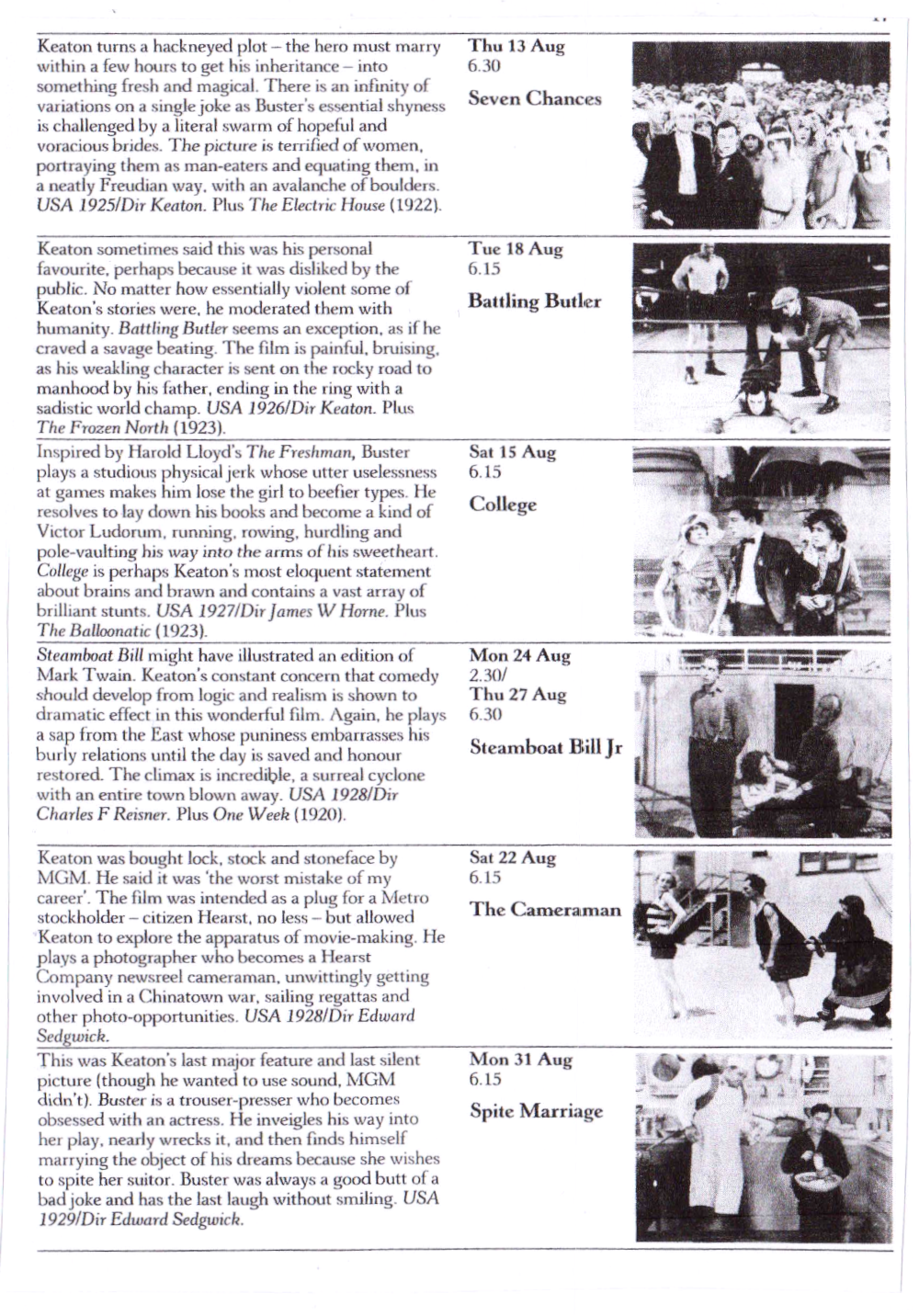 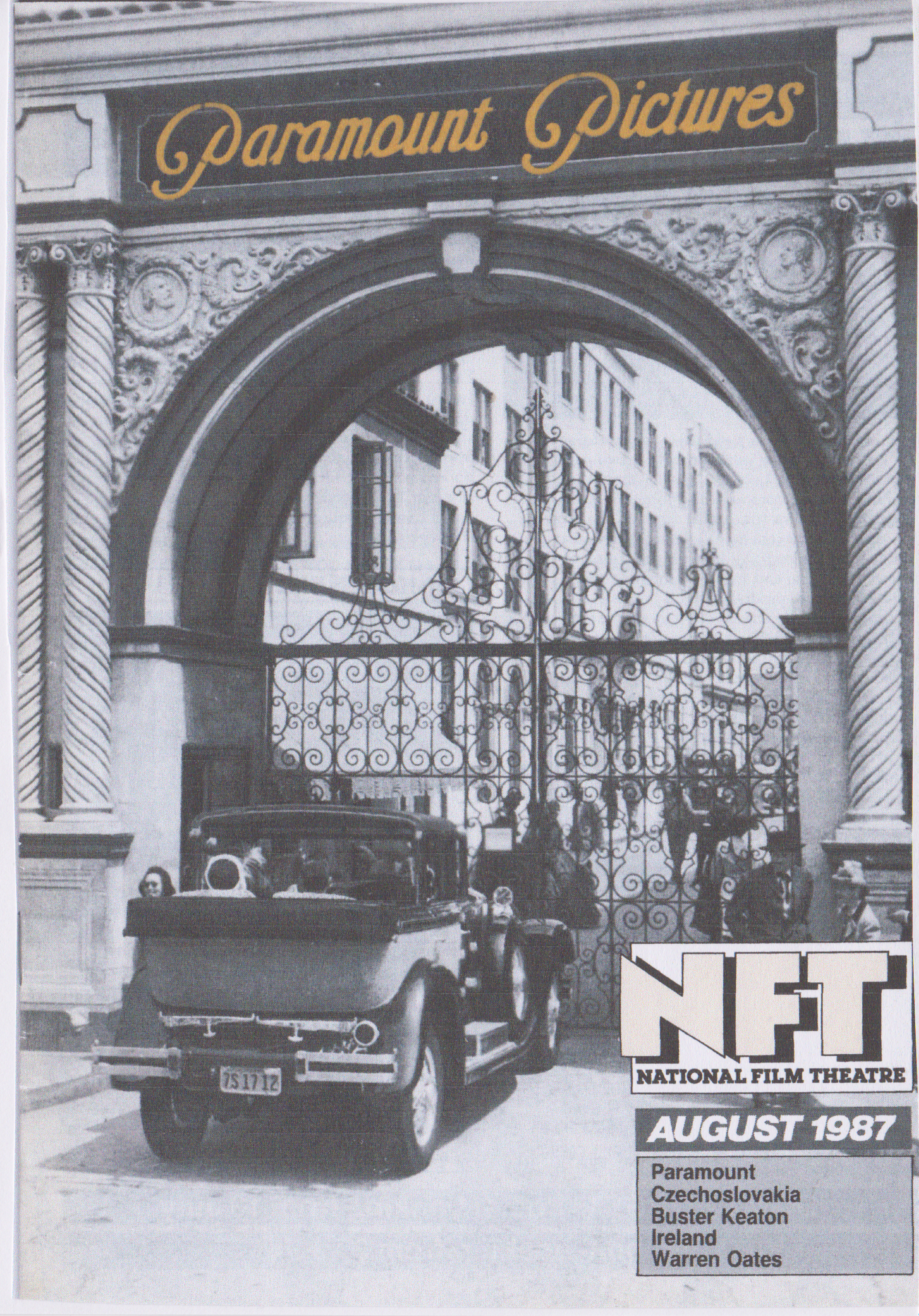
|
|
In 1987, the Evening Standard gave me an even greater shock —
a tiny advert for The General at the London Palladium for one night only
with live orchestral music by Carl Davis, supported by One Week and .......
Hard Luck! The last missing Keaton Studio short, found at last!
I bought tickets as soon as I could, and what an evening it was.
|
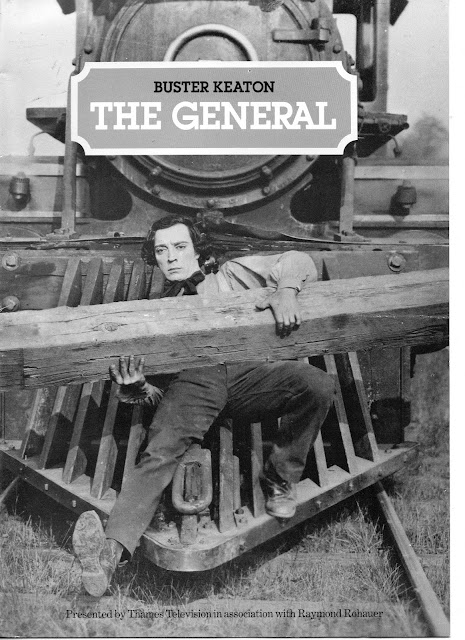 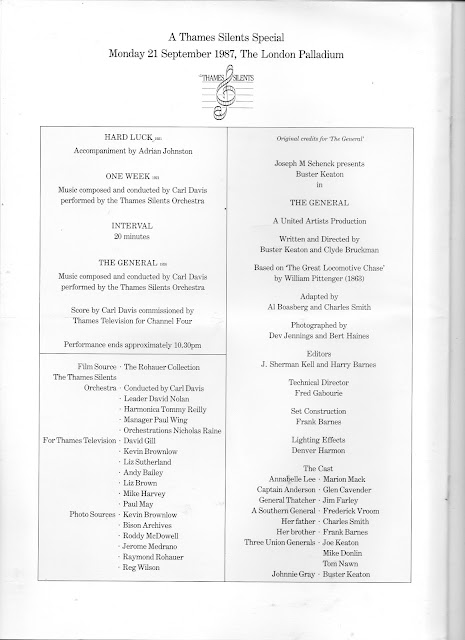 Sorry about quality. My brochure went missing, and this is all I could find on the internet. |
|
The show print of Hard Luck can be seen on “The Art of Buster Keaton”
and, to better advantage, on Kino’s Ultimate shorts set.
Apart from Rohauer main titles, the prints of One Week and
The General had original titles throughout.
David Gill introduced the shorts.
Kevin Brownlow and Eleanor Keaton introduced The General.
Carl Davis and the Orchestra accompanied One Week and The General.
One-man band Adrian Johnston did a terrific job accompanying Hard Luck.
Performing mostly on keyboards, he nevertheless added a deft effect on slide whistle
to substitute for the missing dive and ended with some subtly comic oriental music to support the still of the Chinese family.
The audience loved the film.
|
|
Some of the announcements made by David Gill and Kevin Brownlow have stayed vividly in my mind.
They may not be verbatim, but they are close! When announcing Hard Luck, Gill said that Raymond Rohauer had found it.
He then looked towards the back of the auditorium and seemed to address the next bit to someone in particular — we assumed Rohauer.
“He won’t tell us where he found it, which is most annoying,
but there’s reason to believe he smuggled it out from behind the Iron Curtain!”
Gasps of approval and a round of applause.
Pure bunkum, but (I discovered later)
it was said for very
|
|
Kevin Brownlow explained that Mr. Rohauer had provided them with a nitrate original
for their Thames TV broadcast of The General,
but the Palladium’s fire regulations prohibited its use,
so he had given them a brand new safety print off the original negative,
adding “It’s a bit dark in a couple of places, a common fault with the American labs,
but it’s still a very nice print, certainly better than anything you will have seen in a cinema before”.
I noticed some darkness only in a couple of shots in reel one.
|
|
During the intermission, between the shorts and the feature,
Brownlow, Gill and Eleanor could be seen in the bar area.
I could get nowhere near them, but I overheard one gent saying
he’d asked them where Raymond Rohauer was and had been told that he was unwell.
|
|
At the end of The General, the audience gave Carl Davis, Eleanor, the Orchestra and Adrian Johnston a huge ovation.
Then Kevin Brownlow stepped forward to the microphone and said “There’s one person we haven’t thanked.
If we give him a huge ovation, maybe we can lift the roof off the Palladium,
and he will hear us!” With that, a very nice
|
|
Only much later did I learn that a terminally ill Rohauer had crept into the back row after the lights went out,
stayed long enough to see Hard Luck, then left during One Week,
because he didn’t want anyone to see him in his emaciated condition.
Had he been in good health and had he stayed to the end,
I’m sure that Gill would have got him up on the stage to take a bow,
and I’m sure the audience, just this once,
would have forgiven him everything and shown their appreciation.
Gill suspected it wasn’t to be, so I imagine his “Iron Curtain”
fairy tale was his way of giving Rohauer a little bit of the limelight.
A nice gesture.
|
|
Buster Keaton died two years before the period covered by these ramblings.
After the Palladium show, Raymond Rohauer returned to New York and died fifty days later.
|
|
Today, Rohauer is remembered, if at all, with hatred, derision, or as the butt of jokes.
Before he appeared on the scene, there was only one widely acknowledged silent comedy genius — Charlie Chaplin.
In the 21st Century, there are two — Charlie Chaplin and Buster Keaton.
Without Rohauer, that would not have happened.
He was no saint.
He sometimes tampered with the films.
He loved to see his name up there on the screen.
He insisted that programme notes referred to him as Mister Raymond Rohauer.
Oh, how he loved that Mr.
|
|
Buster Keaton’s talents have enriched my life.
Without Rohauer’s Academy Seasons, I may never have discovered those talents.
And so, thank you Mr. Rohauer.
Thank you very much indeed.
|
|
A Postscript:
|
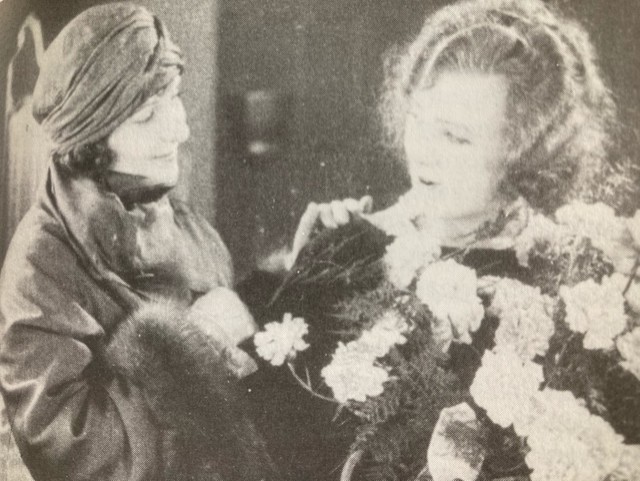 Norma Talmadge & Margaret Leahy, frame |
|
Today, Keaton’s films have been (to coin David Shepard’s phrase)
“
|
|
Circa 2000, my wife and I saw Battling Butler at the NFT
(a standalone matinee, not part of a Keaton season) and the source print was credited to Channel Four TV.
Although shown with live piano accompaniment, it was a Rohauer sound print, with a credit to Lee Erwin at the end.
Rohauer had changed the titles throughout, and not for the better.
Afterwards, my wife wanted to know about the Lee Erwin credit
and why one of the titles said linament instead of liniment.
Some hasty explanations about RR ensued.
|
|
Circa 2002, the newly found The Cook was supposed
to get a London screening with other silent comedy rarities.
I couldn’t go, but later heard that the George Eastman House print
wasn’t ready in time, so the programmers reached out to the Douris people for a Keaton & Arbuckle substitute.
They got The Rough House, the same print as shown at the NFT in 1968.
It had been sitting on a shelf in London all that time, unshown, and was still wrongly titled “The Cook”!
|
|
All the best,
|
|
Richard
|